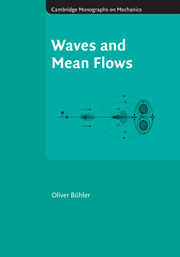Preface
Published online by Cambridge University Press: 29 March 2010
Summary
The aim of this book
This book is on waves in fluids and on their interactions with mean flows such as shear flows or vortices. Such interactions are generally a two-way street, with the waves being affected by the mean flow whilst the mean flow itself responds to the presence of the waves. For instance, readily observed examples of waves affected by mean flows are surface waves propagating on a sheared river current, or ripples that are refracted by a bath-tub vortex. Mean flows that are responding to waves are slightly less easily observed, here examples are given by the classic phenomenon of acoustic streaming, by longshore currents driven by breaking waves on beaches, and, as it turns out, also by many other flows in the atmosphere and ocean. Not surprisingly, wave–mean interaction theory is a very important topic in geophysical fluid dynamics (GFD).
For instance, the wave-induced transport of mass, momentum, and angular momentum plays a crucial role for the long-term evolution of the global-scale circulation in the atmosphere and the ocean, and for such complex multi-scale phenomena as the stratospheric ozone hole. However, many waves that contribute significantly to this transport are much too small in scale to be resolvable by even the most powerful present-day supercomputers, which implies that these small-scale waves, and their interactions with the large-scale mean flow, must be ‘parametrized’ in numerical models, i.e., they must be put-in by hand based on a combination of theory and observational data.
- Type
- Chapter
- Information
- Waves and Mean Flows , pp. xv - xxPublisher: Cambridge University PressPrint publication year: 2009

